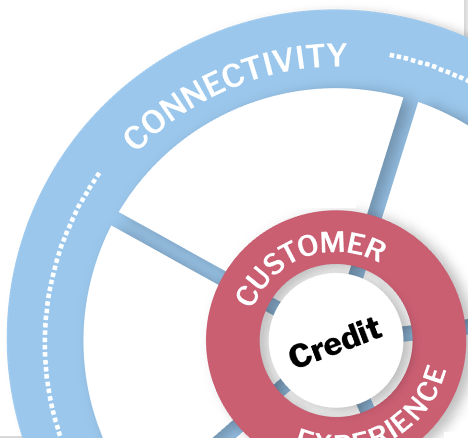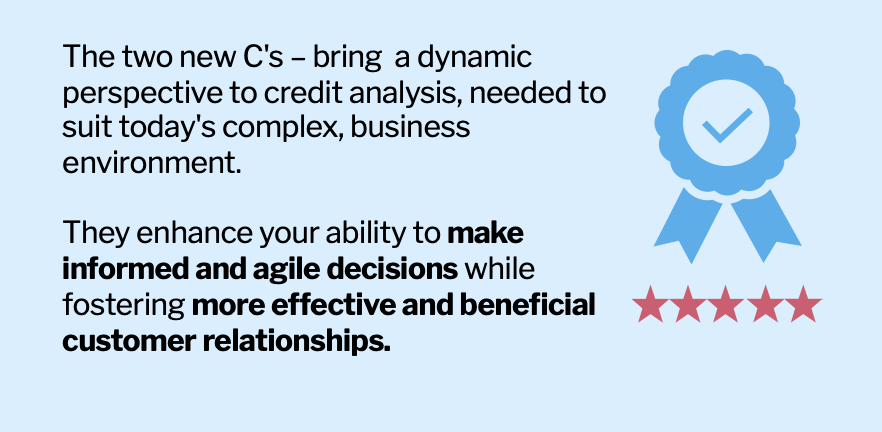Credit Assessment Has Been Same…
Same For decades – It’s Time For Connectivity!
The financial world has for decades relied on the traditional 5 C’s of Credit to evaluate the creditworthiness of potential borrowers.
This framework has indeed served its purpose, forming the basis for countless loan approvals and denials, shaping the financial futures of individuals and businesses alike.
As we venture into an era characterised by a more complex financial landscape, innovation and technology that has never been available before, awareness of data – who has it, how to get it and how to use it – the traditional 5 C’s will no longer suffice.
The rapidly evolving landscape demands a simpler, and a lot more accurate approach to credit risk analysis using real time, dynamic data feeds.
First, an overview of the Traditional 5C’s of Credit …

1. Character
Character refers to a borrower’s reputation or track record for repaying debts. It’s the lens through which lenders view an individual’s credit history, gauging the reliability and responsibility of the borrower.
🛑 Limitation: While this can offer insights into past behaviours, it doesn’t necessarily predict future actions or account for potential changes in a borrower’s circumstances. Over-reliance on past credit history can potentially overlook capable borrowers who’ve had past issues but are now in a better financial position.
2. Capacity
Capacity assesses a borrower’s ability to repay a loan by evaluating their Debt-to-Income (DTI) ratio. It helps lenders estimate whether the borrower can comfortably handle the financial obligation.
🛑 Limitation: Although the DTI ratio is valuable, it doesn’t provide a complete picture. Solely relying on it can miss other crucial factors like job stability, income growth potential, or an imminent expense increase.
3. Capital
Capital examines a borrower’s financial assets and investments. The more capital a borrower has, the more likely they are to be able to repay their loan, making them a lower credit risk.
🛑 Limitation: Some borrowers may have considerable capital but also high and recurring financial obligations. In such cases, their significant capital does not necessarily equate to low credit risk.
4. Collateral
Collateral refers to assets that a borrower pledges to secure a loan. In case of default, the lender can seize these assets, decreasing the potential loss.
🛑 Limitation: Although collateral can reduce risk for the lender, it isn’t an infallible indicator of credit risk. The value of specific collateral can fluctuate, and liquidating collateral can be time consuming and costly.

These traditional approaches overlook the value of building and maintaining strong, positive customer relationships, which yield valuable insights and promote trust.
Our current climate requires credit risk models to evolve. This ensures that they are more encompassing and factor in more diverse and dynamic criteria.
It’s here that the two new “C”s come into play.
6. Customer Experience
Given the high risk environment, it’s even more crucial that businesses understand and foster their relationships with customers. This involves analysing customer interactions, feedback, satisfaction levels, and overall engagement with the company.
A satisfying customer experience can lead to repeat business, timely payments, and reduced risk.
Disregarding the importance of customer experience is akin to carelessness. This argument hinges on three critical factors: customer loyalty, brand reputation, and profitability.
❤ Customer Loyalty: The foundation of successful businesses is built upon retaining and nurturing their existing customer base. This is not different for customers attaining credit. Without attention to customer experience, businesses risk losing loyal customers to competitors who prioritise their needs and expectations.
🥾 Brand Reputation: A single negative customer experience can quickly escalate and damage a brand’s reputation.

On the other hand, consistently positive customer experiences can bolster your market position as a lender/supplier of choice through word of mouth recommendations.
💰 Profitability: Studies consistently show a positive correlation between customer experience and business profitability. Accordingly, a satisfied customer is more likely to purchase again, spend more, and to recommend the business to others. On the contrary, a poor customer experience can lead to lost sales and the additional costs associated with gaining new customers to replace those lost.
In the context of credit functions, failing to prioritise the customer experience can mean neglecting valuable opportunities to learn more about customers, to anticipate their needs and potential credit risks, and build strong relationships that benefit both parties.
It’s important to remember that the “customer” in this context is the borrower. Their experience and satisfaction with the credit process can greatly impact their financial behaviour. This includes their likelihood of repaying debts quickly and fully.

7. Connectivity, that ties all the “C”s together
Finally, the piece de resistance – Connectivity. In a volatile and ambiguous world, having up to date, accurate, and comprehensive information is critical.
Connectivity, enabled by technology and automation, helps pull together disparate data points, perform real time analysis, and generate actionable insights. This enhanced and interconnected view can better equip suppliers to anticipate risks, understand customer behaviour, and make informed credit decisions moving away from ‘static decisioning’ to ‘real time decisioning’.
Technology and automation, denoted here as ‘Connectivity’, don’t simply exist in isolation. Instead, they create a complex network of data, insights, and predictive capabilities that interlink and reinforce each of the other “C”s:
1. Character:
Utilise technological connectivity to amalgamate and analyse diverse behavioural data points from numerous sources. This provides a deeper, more nuanced insight into a buyer’s character, extending beyond traditional measures like credit history.
2. Capacity:
Advanced algorithms consider a broader range of financial data, not just Debt-to-Income (DTI) ratios. This holistic perspective enhances the understanding of a buyer’s actual capacity to repay debts.
3. Capital:
By leveraging technological connectivity, you can factor in dynamic financial information beyond static capital measures. Access to real time financial data provides a more transparent, more accurate picture of the buyer’s ongoing financial health.
4. Collateral:
Technology allows precise tracking and recording of assets, ensuring that collateral value is accurately represented and constantly updated.
5. Conditions:
Connectivity can incorporate real time data giving you visibility as context changes. For example, in trade-credit connectivity, you can set up to be alerted when critical events happen or change that might increase your risk profile with a particular borrower.
6. Customer Experience:
Employing technology makes processes more efficient and seriously reduces friction. Hence it becomes a more pleasant and enjoyable experience for all. Plugins can open multiple entry points for customers to apply for and be approved for credit with omnichannel ‘click of a button’ automation.

The principle of connectivity addresses these gaps by facilitating real time data analysis and interconnectivity. Leveraging technology and automated data collection allows us to persistently monitor each C. Thus, it enhances the precision and timeliness of credit risk assessments.
Additionally, connectivity promotes an integrated approach to credit risk, acknowledging the dynamic interplay among the C’s. It helps us to consider how changes in external factors could affect a borrower’s capacity or collateral value, leading to a more sophisticated understanding of risk.

Solving the shortcomings, together
Admittedly, without the boom of cutting edge technology within our grasp, orchestrating a seamless customer experience within the credit onboarding process might have been an insurmountable task.
Yet, with the evolution of technology, we are now equipped to deliver a “consumer-grade” experience in credit management, mirroring the responsiveness and personalisation inherent to consumer industries. The path ahead for credit analysis involves a significant shift: from a solitary process that often neglects the inherent value of cultivating robust, positive customer relationships, to one that prioritises and nurtures these relationships.

We must transition from this ‘as is’ state of affairs to a future – a ‘to be’ – where credit analysis is an interconnected process. This shift marks the evolution of credit analysis from a single-faceted assessment to a dynamic, relationship-driven process.
Integrating the focus on customer experience into our modus operandi, we are driven by the mutual benefits that stem from a comprehensive understanding of and the ability to cater to our customer’s requirements.
It equips us with a newfound connectivity and immediacy, harnessing the power to transform credit services into an interactive platform where customers can assess and grade their experience just as they would with any consumer-grade service.
This profound focus paves the way for a reimagined credit process, not only making it more efficient but also more personalised.
Read more below:





